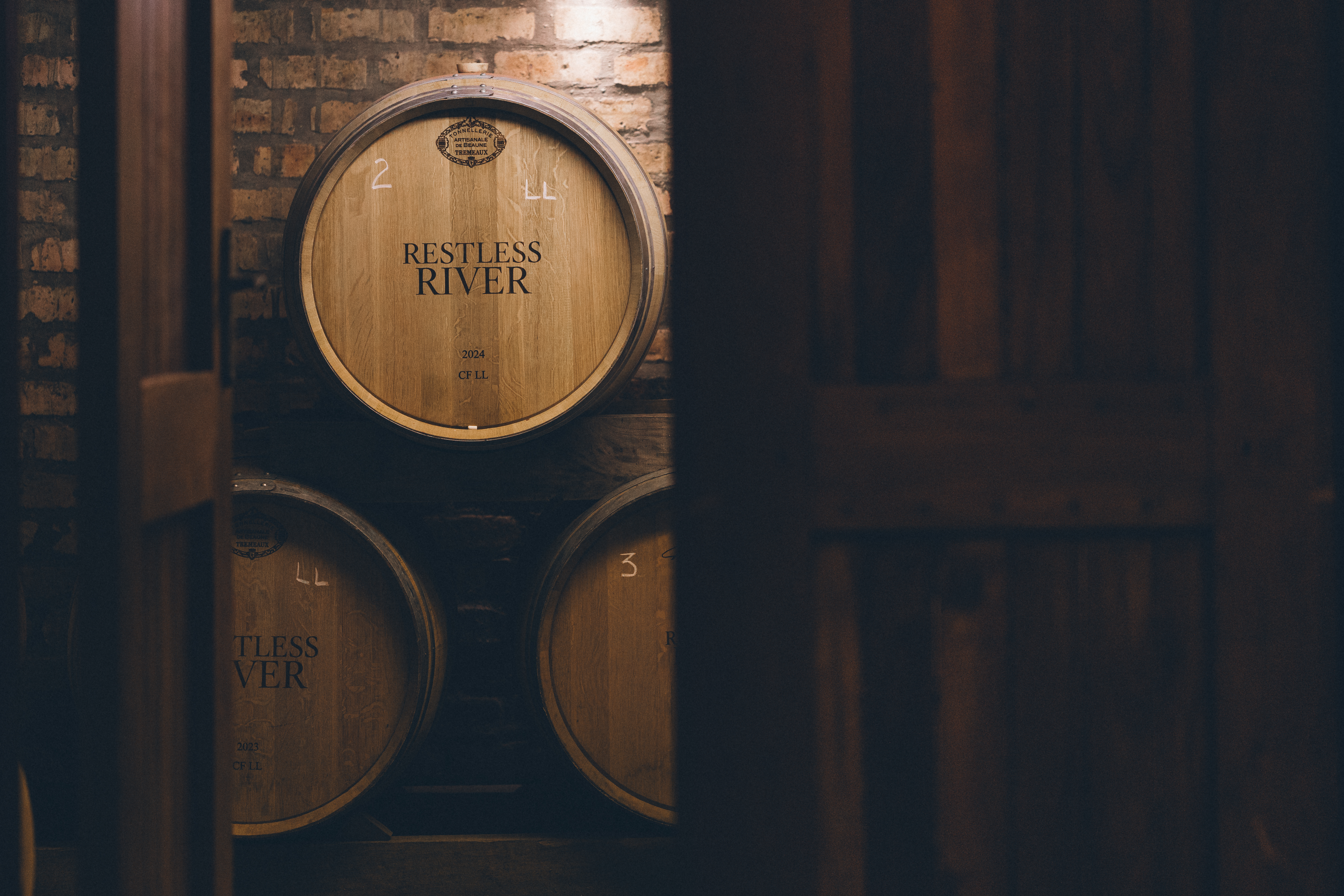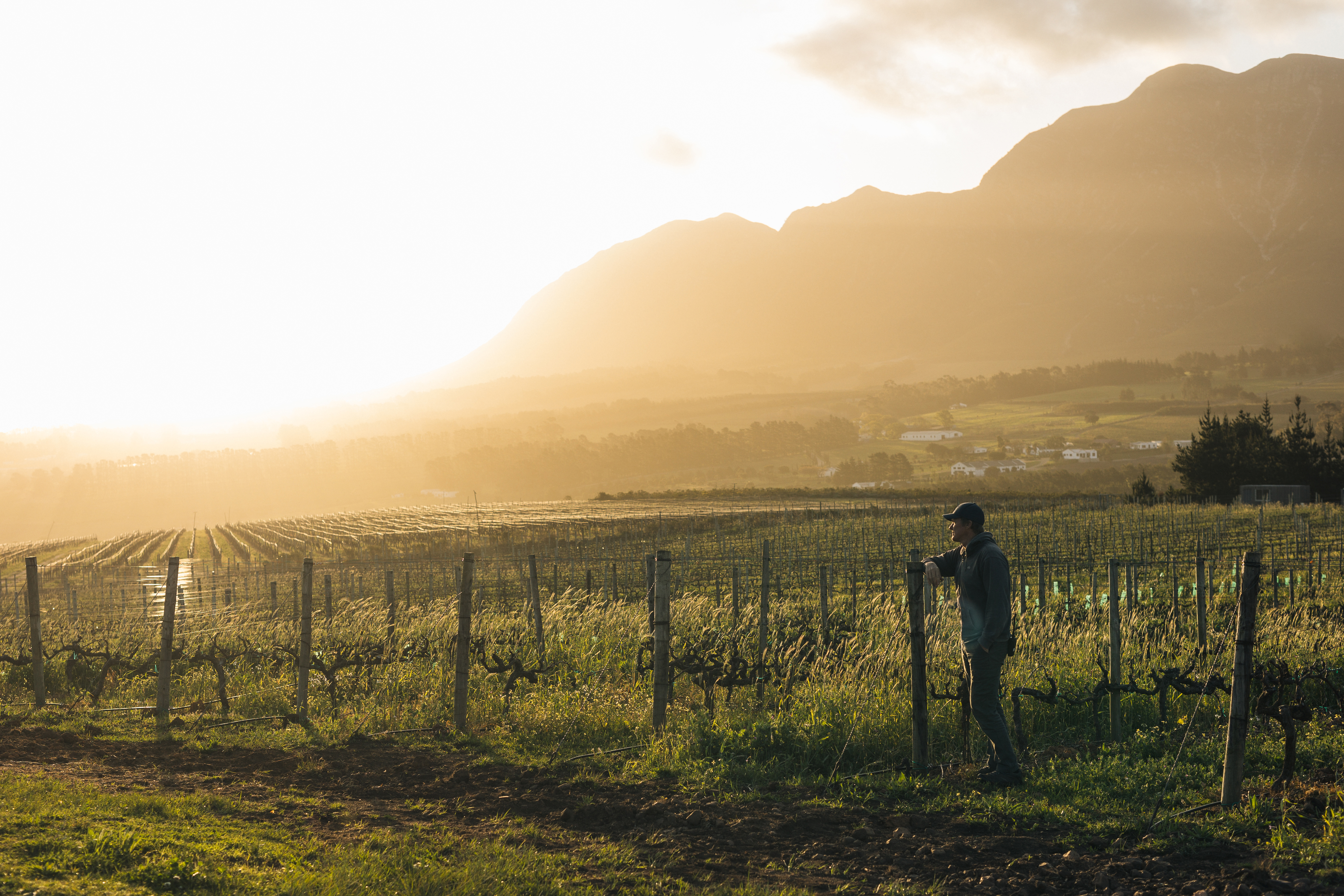Driven by equal parts curiosity and ambition, Craig Wessels pioneered an unlikely path from rogue outsider to industry leader in the Hemel-en-Aarde. Like himself, his wines are self-assured outliers that challenge the status quo.
We sat down with him and his son, Luke, ahead of our Champagne and South Africa Tour to learn more about their family business, Restless River.
Hey, Craig and Luke! How are you guys?
Craig: We’re good. We’re coming out of a pretty cold winter. Spring’s pretty chilly as well. We had hail today. A lot of rain, and a bit of hail. But Wednesday could be 30ºC (86ºF). That’s our spring.
For our readers who don’t know you, can you tell us how you started Restless River?
That’s quite a long story, so I’ll try to keep it short for you. I had a different life prior to becoming a winemaker and wine farmer. I worked in TV production at a visual effects animation studio, and I directed some commercials and music videos as well.
During the course of that whole career, I purchased a farm because I wanted my kids to get out of the city and grow up in a more rural environment. The farm that we purchased in Hemel-en-Aarde, which is the one we’re on now—and have been for 20 years—had a couple of hectares of vineyards already on it.
By then, I was getting into wine, so I tried making some out of curiosity, just for private consumption, as a hobby. I figured it couldn’t be that difficult and… Yeah. I soon realized I was wrong. Owning a farm and planting vineyards and making wine is an even deeper black hole than restoring cars and playing with motorcycles and other stuff that I like to do in my spare time.
For many, many years I was a creative by day, a winemaker by night, and a farmer on the weekends. It was quite tough for a long time, but I think, like anything, if you really love it, you look past the difficulties, and it just grows. We didn’t have any corporate investment and trust funds to work with, so we did it on our own over time.
When you were learning how to make wine, did you have any mentors or friends in the area who were showing you what to do, or was it more intuitive?
Our region is almost exclusively known for Chardonnay and Pinot Noir. When we bought the farm, it didn’t have any Pinot, and instead I was the only one with Cabernet Sauvignon in the area, so I had no mentor. The closest Cabernet guys were in Stellenbosch. It was an hour and a half drive, and besides that, I was an inkomend—an “outsider”—so they didn’t really like me very much. I didn’t study at the institutions that they went to, so no one was particularly keen to help me out. It took eight vintages before I really felt I was getting a good grip on the farming of the grapes and how to deal with that in the winery.
On the Chardonnay side, I started out collaborating with Kevin Grant from Ataraxia because we started our farms at a similar time. After about five years, there were things that I wanted to do differently, and I didn’t feel that it was going to work if we were together. I went on my own path again.
I started Pinot Noir in 2016, and again had no one. It took a bit longer to figure out than perhaps it would have, had I worked for someone else prior.
I think I’ve been more inspired by areas and styles than by people. I don’t like the big, bold, heavily oaked, high-alcohol style, which sounds obvious now, but when I was starting in 2005, those wines were ruling everything, and I was very anti that. Even then, I was barely using any sulfur and very little extraction, and I’ve been doing wild fermentation since the beginning. I was doing stuff that people now take for granted, but I was doing it in 2005, so I was considered quite extreme.
What inspired you to avoid sulfites?
Two reasons, really. I was looking at what people were doing, and I have this innate thing where I don’t believe that things should be done just because that’s the way they are done. I like to challenge conventional wisdom. But I’m also very allergic to sulfur myself, so I didn’t want to put all that stuff into my wine. I wasn’t schooled in wine at that stage, and I was at the beginning of my learning experience, so I was doing it with this naive confidence where I wasn’t aware that there could possibly be quite serious implications if things went wrong due to lack of sulfur or low sulfur. It’s not an answer that is about wanting to try and change things. It was purely just my feeling at the time, not based on any trend because it wasn’t a trend at that stage.
In fact, quite a few winemakers used to tell me I was an idiot. Then they started tasting the wines. I can remember back when natural wines were becoming more popular, there was a competition for low intervention, lower sulfite, South African wines. We’ve never entered an award competition, so that didn’t interest us, but my neighbor—after he saw what I was doing with hardly any sulfites—decided to try a similar thing, and he ended up winning this huge cash prize. It’s quite funny now.
For someone who’s less familiar with South African wine, what do you feel like makes the upper Hemel-en-Aarde unique? Why did you decide to move there?
It’s beautiful. Back when it was on the market, I went to have a look at it on a Sunday, I bought it on Monday, and then I told Anne (my wife) on Tuesday.

We’ve never lived more than 20 kilometers from the ocean. The ocean has been a very, very important part of our life. So, whether that’s spending time on the beach, swimming, surfing, diving, or fishing, we’ve always been connected to the ocean. When we were looking for a place to set up camp, that was quite an important factor.
And on the aesthetic side—you know, I am quite observant of it, of aesthetics—this area is very, very beautiful, so we’ve got this breathtaking area to live in.
We also liked the pioneering spirit of the area. It’s got a very wild and undiscovered feel to it. Our roads were paved only recently. Actually, they’re busy with some of the paving right now.
Also, its wine potential has only recently been discovered. The first grapes were only planted in 1976. So, even as a wine region, it’s extremely new. Not a lot of people knew about it for making really beautiful wines, so from a winemaking point of view, it was very appealing. The style of wine that we’re able to make in this area very much suits the style of wine that I love, and this valley does that relatively effortlessly.
What do you think people tend to misunderstand about South African wine?
One of the key things that I’ve picked up from “the civilized world” is that we are much older than people realize. We’ve been making wine for 350 years. A lot of people don’t realize that. We’ve been making wine here before the States, Australia, or New Zealand.
I think people also don’t realize how sophisticated the wine industry is here. By that, I mean the quality of our wines, the quality of the wine estates, the viticulture, the hospitality. When you come to South Africa, and you tour around Stellenbosch, and you look at these beautiful, old vineyards and how well kitted out the wineries are and the restaurants and all the service behind it all, it’s very unexpected for people who haven’t really been exposed to wine from what is technically a “developing” country.
I think the most surprising thing is the quality. First people go, “Wow, these wines aren’t shit.” Then they say, “These wines are actually really good.” And then people realize, “I’m getting a lot of value for what I’m paying for these wines relative to the same quality from other countries.”
South African winemakers are also an amazing community of open minded, happy, generous, fun-loving people on the whole. Obviously, there are people like me, but the rest of them are just really nice people.
I heard a lot of them surf too. Do you have a group of other winemakers that you go surfing with?
Yeah, a lot of us surf. We have an annual get-together where we have an informal, fun competition. More drinking than surfing gets done. It’s a really great day. It’s a really popular thing, and I think it’s got to do with the fact that most of the winegrowing areas are on the coast. Luke did his first vintners’ competition this year. Now that he is officially working in the industry, he was allowed for the first time to participate, but prior to that, he was just doing the drinking.
A very important job, too. Luke, what’s your role at Restless River, and where do you see it growing?
Luke: We are a family business—and not a large one—so my role fluctuates. Just as farming follows the seasons, so does my job role. I’m trying to help out everywhere, trying to get my knowledge up. I help with harvest, I help sell the wine, and I’m currently working on a website for us as well. I understand that I’m still quite young and have much, much more to learn, so I’m trying to listen and observe wherever I can.

I have to ask, Craig, which bottle are you most excited to show people when you come on the tour?
Craig: Argh. What an impossible question. Because it’s America, I would probably say the Main Road & Dignity Cabernet Sauvignon. Also, because it’s the least expected from the Hemel-en-Aarde. It’s very much an outlier wine. I’m on my 20th vintage now, so it’s quite special, that wine.

It also divides the room nicely. There’s no gray area. You either like it or you don’t like it. And I quite like that. A good wine does not necessarily mean everybody likes it. A good wine is something that really makes people think and questions the status quo. There’s something a little more interesting about wines that are slightly unexpected.
This interview has been edited for length and clarity.
The Wines

Cabernet Sauvignon ‘Main Road & Dignity’
- 100% Cabernet Sauvignon
- Main Road and Dignity are two single vineyards that are the oldest Cabernet Sauvignon vineyards in the Upper Hemel-en-Aarde, planted in 1999
- Granitic rocky topsoils including koffie klip, heavy clay subsoil
- Hand harvested
- Basket pressed and fermented with indigenous yeast
-
Released after 2 years in barrel and 2 years in bottle

- 100% Pinot Noir
- The Le Luc is a single vineyard that was planted in 2012
- Granitic rocky topsoils with heavy clay subsoil
- Hand harvested
- Fermented with indigenous yeast in small open-top oak vats
- Aged for 12 months in 228L and 500L French oak, 25% new
-
After a further three months in tank, and 18 months in bottle, the wine is released

- 100% Chardonnay
- The Ava Marie single vineyard is the oldest Chardonnay vineyard in the Upper Hemel-en-Aarde, planted in 1999
- Granitic rocky topsoils with heavy clay subsoil
- Hand harvested
- Whole bunch pressed
- Fermented with indigenous yeast in 90% French oak (10% new) and 10% unlined Tuscan terracotta amphora on the lees
-
Released after 12 months in barrel, a further three months in tank, and 18 months in bottle








